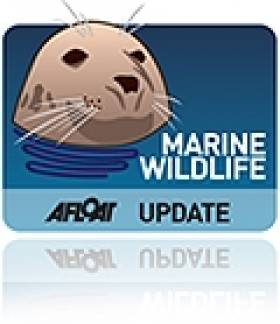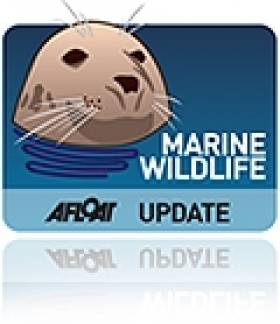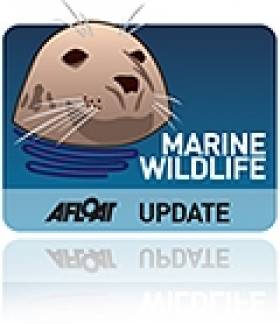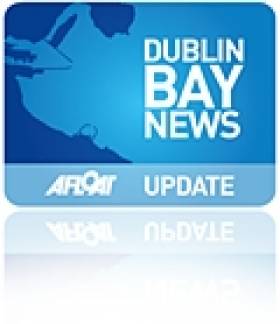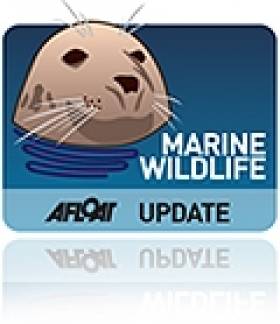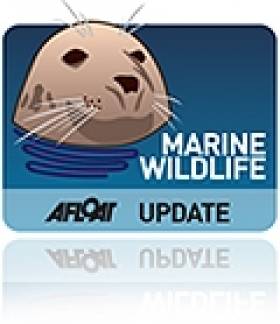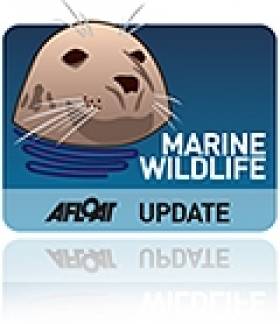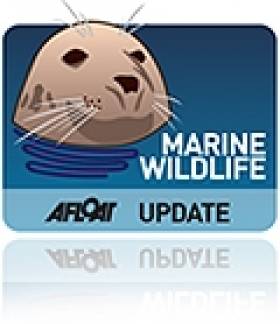Displaying items by tag: marine wildlife
Minke Whale Calf Beaches On Lough Foyle Shore
#MarineWildlife - A minke whale calf has died after beaching on the shore of Lough Foyle near Limavady last week, as BBC News reports.
The whale, thought to be just three months old, was first spotted by locals washed up on the beach in Myroe on Friday 29 May and was encouraged back into the sea, but was later found deceased in an emaciated condition on Tuesday 2 June.
"We assessed the situation and noted that the animal was an unweaned calf about three months old and apparently separated from its mother," said a spokesperson for Norther Ireland's Department of Environment, which has since removed the carcass.
"The calf was severely malnourished and had suffered extensive injuries during its several standings."
The spokesperson confirmed that there is no correlation between this stranding and the recent mass stranding of pilot whales off the Isle of Skye in western Scotland.
According to the Irish Examiner, nine were lost from the group of 21 whales that beached at Staffin in the north east of the Inner Hebridean island on Tuesday 2 June.
The incident is the worst since 16 pilot whales died after stranding near St Andrews in September 2012.
#Biodiversity - Coastwatch volunteers taking part in events for National Biodiversity Week have discovered a massive honeycomb reef as much as a kilometre long in the Waterford Estuary.
Members of the public began checking the shore between Hook Head in Co Wexford and Annestown in Co Waterford on Monday 18 May, an area that has previously shown signs of honeycomb reefs.
But volunteers were astounded to make this latest massive discovery, and Coastwatch members are working to ascertain if it might be the biggest reef of its kind in the world, a record currently held by Saint-Malo in Brittany.
Karen Dubsky of Coastwatch Europe said "first results look very encouraging. We are looking for more surveyors to give an hour and search their shore."
Events continue till Monday 1 June for Ireland's National Biodiversity Week 2015, with today (Friday 22 May) being International Day for Biological Diversity.
Upcoming flagship events include a marine wildlife-watching trip to Lambay Island next Wednesday 27 May, but the event calendar lists a whole host of activities both around the coast and inland throughout the country.
Pollution Threat To Ireland's Killer Whale Regulars
#MarineWildlife - "High pollution levels" could be to blame for the failure of Ireland's only resident killer whale pod to produce any calves.
As reported two years ago on Afloat.ie, the well-known orca pod often seen between Scotland and Ireland has been judged to be on the 'brink of extinction', with its conservation status described as "critical".
Since then the pod's number has dwindled from nine adults to just seven, with no juveniles recorded in the 30 years the so-called Scottish West Coast Community has been monitored by researchers.
One reason for that, posits Dr Simon Berrow of the Irish Whale and Dolphin Group (IWDG), could be "high pollution levels" in the food chain which may have rendered them infertile.
“If you’re moving all around Europe and living a long time, you get a lot of contaminants from fish over time,” he told the Irish Mirror.
That's a theory backed up by evidence of pollutants detected in whale carcasses beached around Ireland in recent years.
Far from the ferocious beasts of horror tales, Ireland's killer whales are considered among the gentle giants in the marine wildlife world - with one recently the recipient of a shark bite on his tail fluke.
Marine scientists have long been interested in the group for their genetic distinctness from other orcas in the north Atlantic, bearing closer relation to their Antarctic cousins.
#DublinBay - "How many capital cities can boast such a rich marine megafauna?" asks the Irish Whale and Dolphin Group's Dr Simon Berrow.
It's an important question as Dublin last week celebrated 300 years of profound change since the decision to build the Great South Wall.
Along with the Bull Wall that followed in the 1800s, it was a project intended to solve dangerous silting in the main channel to Dublin Port.
But together, they completely reshaped the environment around Dublin Bay into a habitat for hundreds of species of marine wildlife - including the aforementioned megafauna like dolphins and porpoises that frequent Dublin's waters.
And it's an environment that's still reshaping today, as the Irish Independent reports - using the example of a toilet block built on Bull Island's Dollymount Strand in the early 1970s but which today, only 44 years on, is nestled deep in the dunes some distance from the beach.
Bull Island itself, which did not exist before the building of the Bull Wall two centuries ago, is now home to nine distinct habitats among the many important sites that round the bay from Howth's sea cliffs to Seapoint's rocky shoreline.
And its biosphere status is one that Dublin City Council wants to extent over an area from Malahide down to Killiney to ensure the bay's proper protection and management.
The Irish Independent has more on the story HERE.
#MarineWildlife - Six weeks after the first sighting of basking sharks this year off West Cork comes news that a pair of killer whales have been seen near Baltimore.
The Southern Star reports on the rare sight for the area of these cetaceans with a fearsome reputation, but who have never been known to kill a human in the wild.
It's believed that the orca duo may be part of a bigger pod that was feeding off West Cork at the time.
And they seem to be happy finding their own food, unlike their counterparts in the Southern Ocean who have taken to nabbing fishermen's catches.
According to the Guardian, killer whales off the Crozet Islands between Africa and Antarctica have learned to grab Patagonian tooth fish off longlines since a fishery was established there some 20 years ago.
Now scientists say they've found a link between this near constant supply of food and the orcas' reproductive rates. In other words, more fish means more, and healthier, killer whale calves.
South American River Rat Found In Tipperary Stream
#MarineWildlife - Rodney is the name given to a giant river rat found swimming in a Tipperary stream last week, as TheJournal.ie reports.
The three-foot rodent is a coypu, native to South America, and is the first of his kind ever found in the wild in Ireland.
After his discovering in a river in Kilnasculy, Rodney is now in the care of the Kildare Animal Foundation Wildlife Unit, whose Dan Donoher believes the animal must have been a kept as a pet before escaping or being released by its owner.
The coypu is better known as the nutria in the United States, where it is regarded as a destructive invasive species and pest, particularly in the southern Gulf Coast region.
But Dononher told RTÉ Radio 1's John Murray Show that there's no fear of a coypu invasion in Ireland's waterways just yet.
Video Shows Basking Shark On Patrol Off Dingle
#MarineWildlife - Following Friday's look back at the basking shark that surprised bathers off Cape Clear last summer, Independent.ie brings us this remarkable up-close video of the ocean giants returning to the Kerry coast for the warmer months.
The footage was captured near Dingle by sea kayaker Noel O'Leary, who said: "I’ve seen the odd minke whale, but to see a shark that's bigger than the kayak so close is quite amazing."
But it wasn't the only surprising sight around Ireland's coast as of late, as Her.ie reports on a 'surfing seal' in Dungarvan.
Apparently, the seal has become somewhat of a local celebrity after taking a liking to an abandoned surfboard at the mouth of the Colligan river.
Whether the cuddly sea dog is ready to take on the big waves of Mullaghmore remains to be seen!
Surprise Basking Shark Features In Cape Clear Documentary
#MarineWildlife - Do you remember the basking shark that surprised a group of bathers off Cape Clear last summer?
According to TheJournal.ie, it's now featured in a documentary shot on the fly by a team of quick-thinking filmmakers.
Aonrú, a film funded by Cork County Council and Bord Iascaigh Mhara, tackles the delicate subject of the West Cork island's future after the decline of the regional fishing industry.
But in the process of filming, they happened to be close by when the basking shark - the second-largest fish in the oceans – made its appearance, the solitary beast almost a metaphor for the island's dwindling community.
TheJournal.ie has more on the story HERE.
Sea Eagle Poisoned In Connemara 'Was About To Lay Eggs'
#MarineWildlife - The remains of a sea eagle – or white-tailed eagle – have been found in Connemara, and experts say the bird was poisoned.
RTÉ News reports on the discovery earlier this month of the female eagle, which was "within days" of laying eggs.
She was one of a pair that settled in the Roundstone area of Galway after her release in Killarney six years ago. Last year the pair laid eggs but they did not hatch.
The gruesome find marks the 13th poisoning of a sea eagle since they were reintroduced to the wild, and comes just weeks after the remains of another white-tailed eagle were found in Fermanagh.
Irish Research Cited In Experts' Rejection Of Japan Whaling Plan
#MarineWildlife - A research paper produced in a joint project by the Irish Whale and Dolphin Group (IWDG) and the Galway-Mayo Institute of Technology (GMIT) was cited by an expert panel that has struck down Japan's plans to resume whaling in the Southern Ocean.
As the Guardian reports, the International Whaling Committee (IWC) panel said Japan's revised programme did to have enough detail to determine whether it needed to hunt whales in order to, as per its reasons, measure population sizes ahead of any return to commercial whaling, or gain "a better understanding of the Antarctic marine ecosystem".
"The current proposal does not demonstrate the need for lethal sampling to achieve those objectives," said the IWC experts' report.
The IWDG-GMIT paper lead authored by Dr Conor Ryan and published in Marine Ecology Progress Series in 2013, which details the collection of relevant data from live biopsy tissue samples, was cited by the experts as evidence contrary to Japan's assertions.
Japan was forced to revise its whaling programme in the face of controversy last year after the International Court of Justice ruled it was not whaling for scientific research purposes.
The IWDG says that the IWC's report "endorses the internationally significant work being carried out in Ireland and shows how this information can be used to inform important management decisions such as that offered by the IWC Expert Panel."
Other recent research work conducted by the IWDG includes a visual and acoustic survey of cetaceans during the annual Marine Institute bus whiting survey, and a review of the National Parks and Wildlife Service's National Cetacean Protection Strategy.


























